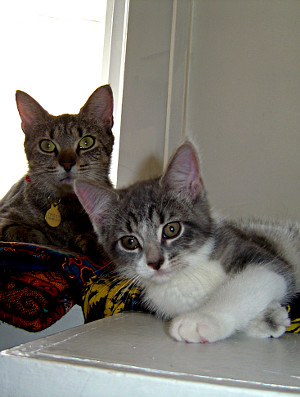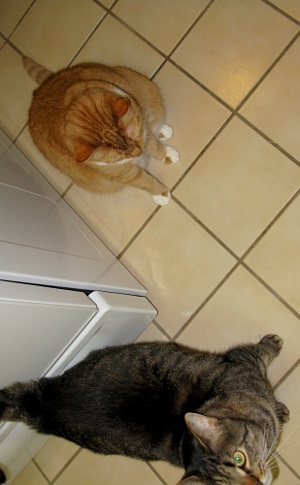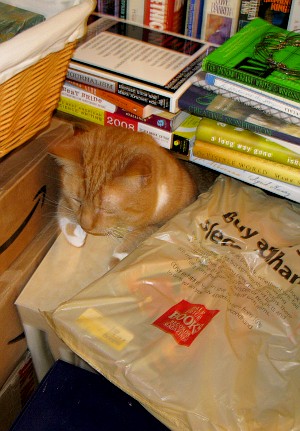We all know cats are territorial animals. When you’re looking to add a second cat to a household, one of the common recommendations is to pay attention to the gender of the cats. The best combinations are Male and Female or Male and Male. Female and Female is about as bad as it gets in terms of creating catfights.
 Matt and I didn’t necessarily have a choice when it came to our second cat, or we did, but Tricky (the cat) made it for us. We’d been wondering for a while what to do about the stray cat on Matt’s street that we were both trying to deny we were growing attached to, and when we realized she was pregnant, we felt like we had to adopt her. (Morepictures of kittens and the sleepy mom posted earlier).
Matt and I didn’t necessarily have a choice when it came to our second cat, or we did, but Tricky (the cat) made it for us. We’d been wondering for a while what to do about the stray cat on Matt’s street that we were both trying to deny we were growing attached to, and when we realized she was pregnant, we felt like we had to adopt her. (Morepictures of kittens and the sleepy mom posted earlier).
We expected problems between Tricky and Chyna, particularly during the pregnant and kitten problem, but we hoped they’d sort of settle down when we moved out, sort of resetting the whole territory issue. It worked to some extent, but there’s always been an undercurrent of tension that rises and falls depending on how much we’re home, the weather, kitty whims. The two of them could be curled up together on the couch and the next day fighting like mortal enemies. Which, in some respects, they probably are.
It took us a while to realize that the largest factor in our cat’s relationship was Matt and my cleanliness.
 The apartment is good sized for a one bedroom, about 950 square feet. The bedroom is large, 17X12. For two people, it’s squished, but livable. For two cats, we thought it would be fine, and sometimes it is. Their square footage is more limited than ours because Matt and I are both allergic to cats: they aren’t allowed in the bedroom. That knocks their shared area down to about 750, which you’d think for two small animals, would still be enough.
The apartment is good sized for a one bedroom, about 950 square feet. The bedroom is large, 17X12. For two people, it’s squished, but livable. For two cats, we thought it would be fine, and sometimes it is. Their square footage is more limited than ours because Matt and I are both allergic to cats: they aren’t allowed in the bedroom. That knocks their shared area down to about 750, which you’d think for two small animals, would still be enough.
When we first moved into the condo, we didn’t have nearly enough space. For Matt and me it’s fine, but our stuff is another matter. Between the two of us, we just have too much crap for one small apartment. Slowly we carved through it, donating or throwing away things we didn’t really need. By the time we got married, the boxes of un-placed crap had shrunk considerably, but the newly found carpet space was quickly swallowed up by new boxes: wedding presents.
In theory we ought to have been able to put most of the wedding stuff AWAY somewhere, getting rid of whatever its replacing, but right now we are STILL working on thank you notes (we’re awful) and we don’t want to put anything away until the notes are sent. So we have a permanent collection of stuff piled in one part of the living room. Thanks to this accumilation of stuff, we have now found the exact tipping point for cats that like each other and cats that hate each other. It’s actually pretty fascinating.
When you factor in furniture, appliances and boxes, actual usable space for our cats is probably around 500 square feet. The pure number isn’t the only factor though, much of it has to do with perception. The dining room table for example, doesn’t really take away any space from the cats. If anything, it adds square footage because the cats are able to use the floor beneath it, the chairs (some of their favorite playthings when they’re friends and playing together) and, even though we try to keep them off, the table top itself. This isn’t reality however, because while their usable space is unaffected, there’s a clear disruption in their perception of space: in the form of a big wooden object. This is further complicated if there happens to be clutter on top of the table, or on the chairs. The couch is similar: although it’s their most frequently used pieces of furniture, it’s clearly taking up part of their territorial space.
 Our cats are tenuously friends, and they have exactly enough space. The slightest change in perception can make them enemies again. If a stacked box is moved down to the floor, the cats have less space than they did a second ago. The air fills with growls and hisses, often nowhere in the proximity of the guilty box.
Our cats are tenuously friends, and they have exactly enough space. The slightest change in perception can make them enemies again. If a stacked box is moved down to the floor, the cats have less space than they did a second ago. The air fills with growls and hisses, often nowhere in the proximity of the guilty box.
My favorite variable is Matt’s drying rack. As mentioned in our blog post, this is one of the typical college dorm types, light narrow wood, collapsible and flimsy. While it’s being used it’s a nuisance to Matt and I, but doesn’t change the cats’ actual space at all. In spite of that, Matt’s drying rack is guaranteed to cause new fights every time he uses it.
I have to think that purely open space wouldn’t be ideal either. Chyna likes her hiding spots even when she and Tricky aren’t clawing at each other. Tricky meanwhile likes climbing on top of things, being up high. The more open space they have, the happier and less touchy our cats seem to be, but this needs to be balanced with their “safe” places for them to be comfortable. I just think it’s interesting that this can all be changed by something as simple as a wet sweater.
Pingback: Topics about Pets and Life with animals » Personal Space (for cats)
Pingback: » Personal Space (for cats) A Certain Lack of Focus | sofanewyork.com
Pingback: Topics about Pets and Life with animals » » Personal Space (for bcats/b) A Certain Lack of Focus